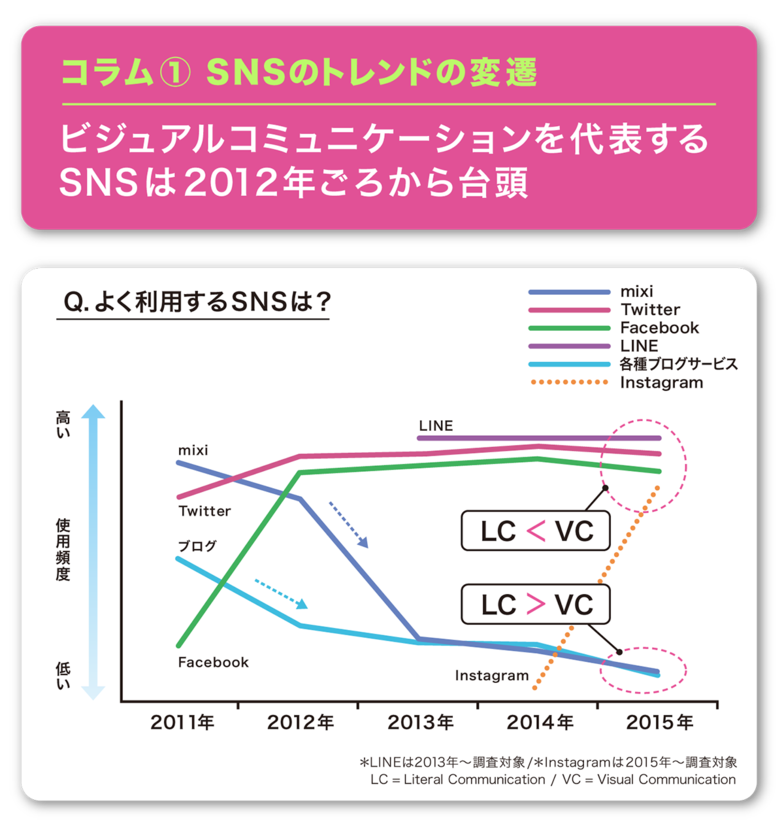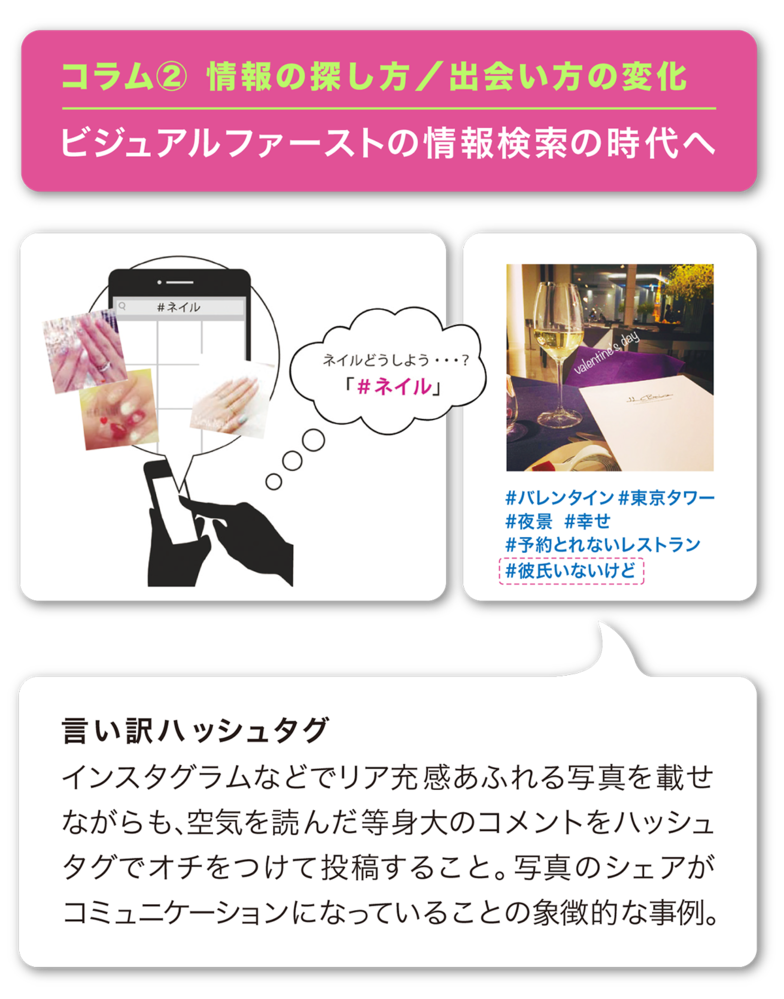Note: This website was automatically translated, so some terms or nuances may not be completely accurate.
The Simulacrum Model: Analyzing "SNS Appeal" to Understand Young People's Information Behavior

Smartphones and the Japanese
While we live in an era where smartphones are ubiquitous, few surveys truly delve into what users are actually doing with them. A joint team from Video Research Ltd. and DENTSU SOKEN INC. has been actively publishing reports on smartphones since last year. This installment of "Smartphones and the Japanese" focuses on the spread of visual communication among young people. It reveals how visual communication—using photos and videos taken with smartphone cameras—is beginning to influence young consumers' spending habits.

Research Team: (From left) Mr. Tsuyoshi Watanabe, Marketing Business Promotion Bureau, Video Research Ltd.; Ms. Kanako Teramoto, Marketing Business Promotion Bureau, Video Research Ltd.; Ms. Mariko Shitara, Media Innovation Research Department, DENTSU SOKEN INC.; Mr. Akira Amano, Media Innovation Research Department, DENTSU SOKEN INC.; Mr. Kenji Koizumi, Marketing Solutions Bureau, Dentsu Inc.
Visual Communication Driven by Smartphone Proliferation
"While exploring the information behaviors of today's youth, whose lives revolve around smartphones, a defining characteristic was their use of 'visuals' like photos and videos for communication. While photos and videos were once primarily for documenting special events, they are now used as tools to share emotions and situations with others.
As a result, while blogs and text-centric SNS were once popular, usage has shifted to SNS platforms like Instagram, Twitter, and Facebook, where words play a lesser role. The 'Harejo Committee', an organization of opinion leaders among current female university students, continuously tracks frequently used SNS. Their findings show a sharp decline in users of text-centric services between 2012 and 2013, with visual-centric services (see Column ①) becoming mainstream.
This period can be seen as a turning point, coinciding with data from the Ministry of Internal Affairs and Communications showing smartphone penetration exceeding 60%. We believe investigating these realities is an essential perspective for understanding trends among young people and future smartphone users. (Dentsu Inc.)
The rise of visual communication, the focus of this discussion, was significantly influenced by the proliferation of smartphones, the accompanying enhancement of camera capabilities, and the evolution of apps and services. Alongside these developments in information technology, the ability to express emotions and situations through easily shareable, expressive photos and videos has diminished the importance of text.
Within this context of information technology and user needs co-evolving in a correlative manner, the trend of visual communication is progressing irreversibly. Furthermore, survey results indicate that while centered on younger generations, this trend is becoming a general tendency among smartphone users across a wide age range.
"A survey by Video Research Ltd.'s Human Research Institute targeting seniors revealed that the 'Love My Life' segment—those sensitive to societal trends who actively enjoy consumer lifestyles—shows a tendency to actively use smartphone camera/photo apps and SNS apps. While this is more conspicuous among younger people, it suggests visual communication is quietly beginning to permeate the senior generation as well." (VR)

From SNS usage survey results for the 'Hare Women's Committee,' an organization composed of 100 active female university students attending universities in the Tokyo metropolitan area. The committee was established and operated by Dentsu Inc. in 2010 to support client promotions and develop media content.
SNS appeal is a key indicator of youth behavior
The driving force behind visual communication is female users in their teens and twenties, who are highly sensory-oriented. They master smartphones and photo/image editing apps, enriching their daily communication with sensory appeal.
This builds on pre-existing cultural elements like the practice of enhancing photos taken in photo booths ("purikura") to look more appealing, and the culture of sharing photos digitally, exemplified by camera mail. A key point in this visual communication is achieving "SNS appeal." SNS appeal can be broken down into two elements: subjects that are photogenic (visually appealing) and subjects that allow users to showcase their "real-life fulfillment" (a sense of having a fulfilling, active life).
The crucial insight here is that in both cases, what young people want to express through photos and videos isn't the objects themselves, but the sharing of experiences: "Look how stylish my life is," "Check out this amazing experience I had." Sharing these experiences sparks mutual admiration, interest, and desire among users – "I want to be like that," "I want to do that" – effectively triggering purchases and actions.
"The key point in visual communication is that the object of aspiration is sharing experiences, not owning things. For example, the recent surge in Halloween popularity (with a market size of ¥122 billion in 2015) was undoubtedly supported by active visual communication; the enjoyment of celebrating and sharing drove the event." (Dentsu Inc.)
We should also note how young people's information-sharing styles have changed as communication on smartphones shifted from text to visuals. Until a few years ago, daily logs were predominantly "diary-style," expressing thoughts through words on blogs. Now, they've evolved into "album-style," centered on photos and videos. A notable characteristic here is that the words accompanying photos posted rarely express genuine emotions (especially negative ones), focusing instead on concise facts. This can be seen as a consideration for the audience, characteristic of young people born and raised in an era of "reading the air." A symbolic example reflecting this aspect is the "excuse hashtags" frequently seen on Instagram lately (see Column ②).
Overall, we can glimpse the impact of visual communication gaining prominence—shifting from one-way communication like blogs to empathetic, two-way communication that enables shared experiences.

For young people prioritizing social media appeal, searching via photo app hashtags is more convenient than search engines because it allows them to intuitively find information that perfectly matches their sensibilities and mood. Furthermore, since the information comes from a limited circle of friends or users with shared interests, it also serves as a trusted source free from vested interests.
Photo apps are search windows for trend information
Thus, the user experience logs accumulated through photos and videos have become a crucial information source for young people. Photo apps now serve as a search window for information when young people learn about trends or decide on consumption actions.
For example, on Instagram or Twitter, users can search for specific information using "#" (hashtags). When considering today's outfit, they might search "#ootd" (Outfit Of The Day), or for the latest spots in Daikanyama, "#Daikanyama". Increasingly, they are drawn to the visuals that appear and this leads to attitude changes or actual actions.
"Influenced by the trend of finding information on Instagram and similar platforms, a survey targeting the Tokyo 50-kilometer radius from April to June last year also revealed that teens are increasingly less likely to use major portal sites and search engines compared to other generations. Search remains important, but sharing on social media is gaining greater significance for these demographics," (VR)
Visual communication thus provides a compelling lens for understanding shifts in young people's information behavior. Furthermore, interactions on social media involve daily, nuanced differentiation based on purpose, considering each platform's distinct tone and etiquette.
For example, Instagram is seen as a high-end space for stylish posts, Twitter as a casual space mixing diverse people and cultures, and Facebook as a formal space where parents and teachers are watching. Visuals, which allow instant information processing, enable viewing vast quantities; anything uninteresting or unnoticeable gets skipped. A crucial point is that unless the style matches the app's worldview and the mood of its users, it won't capture the audience's attention.
Moreover, the advantage of visual communication lies in expressing things that are difficult to convey with words or that people wouldn't normally say. For example, celebrities can reveal unexpected private sides or friends' secretive aspects through photos and videos, creating opportunities for connection.
For companies and products, this approach is expected to contribute to branding and engagement by conveying their worldview and deeply sharing the appeal of the product. Real-world examples of this are beginning to emerge.

Instagram-linked tie-up advertising for the women's fashion magazine 'JJ' (Kobunsha). This project featured product promotion in print while introducing the brand's worldview through videos on Instagram. By transforming content format from one-way print media to video and leveraging each platform's strengths, it significantly expanded print media's potential. It also contributed to building engagement between the brand and consumers, garnering highly favorable comments.
A New Information Transmission Model for the Visual Communication Era
"While it's unclear who started it, a pattern of photographic styles everyone wants to emulate has emerged. This trend increasingly translates admiration and interest into consumer behavior (see Column ④). Unlike the conventional "mass model" and "influencer model," where information is disseminated and spread from a single point, causing people, things, and events to move, a new model of information transmission called the "simulacrum model" has emerged, in which the original source of information remains unknown, and before we know it, many people empathize with and copy the experience. The important thing is that these three models do not transition in a linear fashion, but rather coexist. In the sense that they occur in parallel, the points that stimulate consumer desire are becoming more diverse and frequent. (Dentsu Inc.)

The original meaning of simulacrum is "a copy without an original." Here, it refers to a state where information originating from an unknown source is copied, creating a common image (something everyone has seen somewhere) that sparks consumer desire, and then spreads as a trend. This is a phenomenon unique to an era where everyone visualizes and shares their experiences.
Simulacrum-type visuals are also expressions of young people's interests, and we have observed information behavior in which users can discover their own preferences through self-feedback using visuals they themselves have posted. In other words, visual communication platforms can be seen as a collection of visualized insights from young people. In an era where people search for information sources, it will become increasingly important to grasp the spread of information among audiences and the resulting trend propagation using this model, in anticipation of future developments such as integration with commerce functions and other platforms for direct purchasing behavior.
Was this article helpful?
Newsletter registration is here
We select and publish important news every day
For inquiries about this article
Back Numbers
Author

Smartphones and the Japanese
Smartphones are poised to significantly transform Japanese lifestyles. In the series "Smartphones and the Japanese," a joint team from Video Research Ltd. and DENTSU SOKEN INC. will investigate the reality of this phenomenon.

